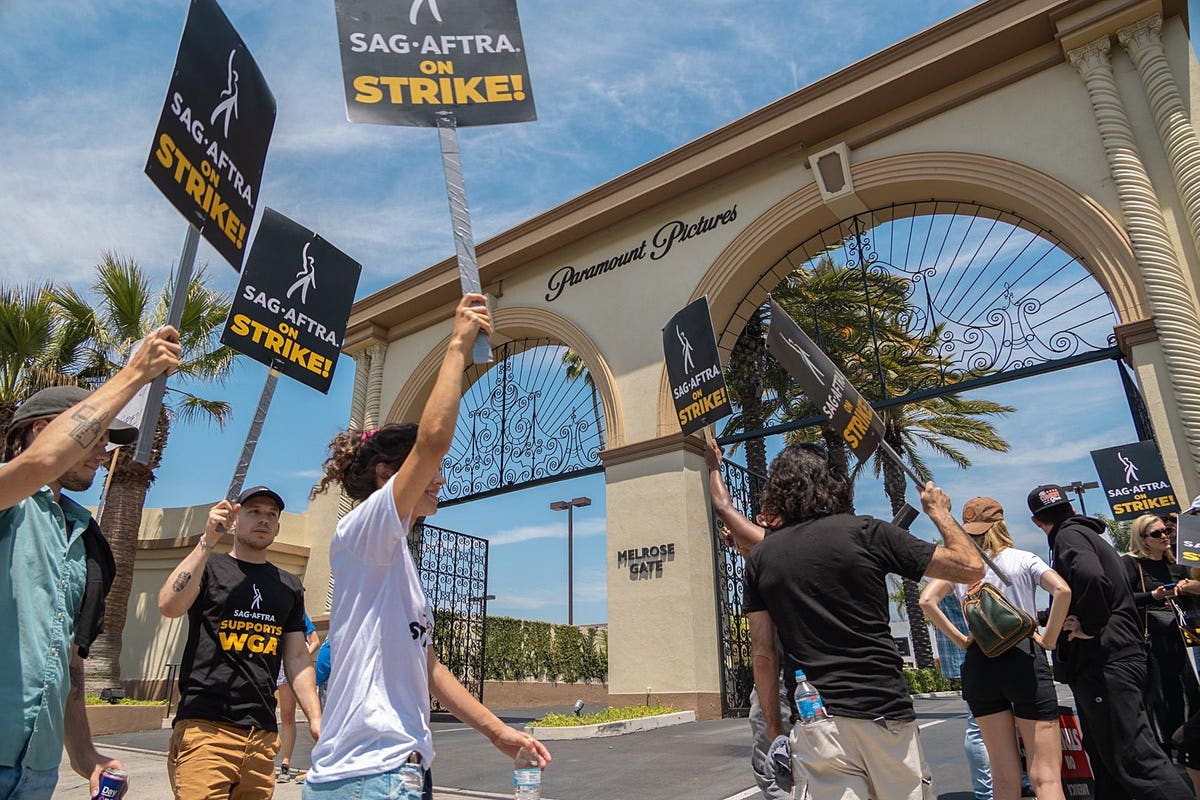Topline
The Hollywood writers’ strike reached its 100-day mark Wednesday following months of heated labor disputes with the Alliance of Motion Picture and Television Producers—here’s a timeline of the key moments that have led to the striking milestone.
Key Facts
March 7: The Writers Guild of America announces nearly 99% of its members voted in favor of demands that included calls for increased compensation, better residuals, staffing requirements, protections from artificial intelligence job interference and more.
March 20: Negotiations between the WGA and AMPTP begin and eventually stall.
May 2: The strike’s work stoppage begins, effectively shutting down late-night programs such as Saturday Night Live, Jimmy Kimmel Live!, The Tonight Show Starring Jimmy Fallon and The Late Show With Stephen Colbert.
May 5: Warner Bros. Discovery CEO David Zaslav says “everybody deserves to be paid fairly” and that his company’s focus is to resolve the strike in a way that leaves writers feeling valued and fairly compensated
May 11: Jeopardy! host Mayim Bialik stands in solidarity with writers and exits the final week of filming for the game show’s 39th season, joining the likes of Drew Barrymore, who stepped down as the host of this year’s MTV Movie & TV Awards for the same reason.
June 5: Nearly 98% of the Screen Actors Guild — American Federation of Television and Radio Artists votes to strike if it cannot reach a deal with the AMPTP by June 30.
June 23: The Directors Guild of America agrees to a new contract with the AMPTP, securing wage increases, better residuals and some protections against artificial intelligence tools.
July 11: A report from Deadline says Hollywood studios planned to let writers go broke before resuming negotiations in the fall, with one unnamed studio executive telling Deadline, “The endgame is to allow things to drag on until union members start losing their apartments and losing their houses”; the AMPTP publicly refuted the report.
July 13: SAG-AFTRA joins the ranks of the WGA and authorizes its own strike, putting several movies and TV shows on indefinite holds and resulting in the cast of Christopher Nolan’s Oppenheimer walking out of the film’s U.K. premiere. Disney CEO Bob Iger reacts to the news, saying writers and actors were not being “realistic” with their expectations.
July 24: Social media influencers are told they will be barred from SAG-AFTRA if they accept work from blacklisted studios or streaming services during the strike.
August 4: WGA representatives meet with studios but fail to reach a deal, saying AMPTP was open to increasing offers on “few writer-specific TV minimums and talk about AI” but wasn’t willing to engage in screenwriters’ issues and other proposals.
August 9: The WGA strike reaches its hundredth day, with no end to its protest in sight.
Big Number
$3 billion. That’s how much the failure to reach an agreement has cost California’s economy, according to California State University, Northridge professor Todd Holmes, who was cited by CNBC Wednesday.
Crucial Quote
“With SAG by our side, we’re more powerful than ever,” Chris Keyser, co-chair of the WGA’s negotiating committee, said in a statement reported by the Hollywood Reporter. “There will be no path forward for writers or for actors who do not say, ‘Enough.’ There is no mercy here; there is only a revolution that comes out of our power. And that’s what we intend to achieve.”
Contra
The AMPTP, which represents studios Paramount, Warner Bros. Discovery, Amazon and Netflix, has said it is committed to reaching a deal with the striking entertainment workers, noting prior to recent negotiations that its only playbook was “getting people back to work.” Following its failed negotiations with the WGA, it said in a statement that it offered a “comprehensive package proposal” to the guild, including “generous increases in compensation for writers as well as improvements in streaming residuals.” The AMPTP said in July it offered a similar deal to SAG-AFTRA prior to its strike that also included an AI proposal to protect actors’ digital likenesses.
Key Background
The current WGA strike is one of the longest that Hollywood has ever seen. It has lasted longer than the 1981 WGA strike, which took 96 days before a deal was reached over writer residuals from sales in videocassettes and pay TV, according to Vanity Fair. The longest writers’ strike of all-time lasted 154 days and took place in 1988, when some participants lost their homes in a contentious stretch of time that reportedly cost the industry $500 million. Today’s strikes are wildly different from those of the past, as some of the pain points for striking workers are rooted in modern streaming services’ business models, which typically promote shows with far shorter seasons than was the norm for scripted network television shows in the past. The WGA has researched the effect of streaming on minimum rates for writers, arguing studios have used the streaming transition to “cut writer pay and separate writing from production, worsening working conditions for series writers at all levels.” Artificial intelligence is also a concern for writers and actors alike, with SAG-AFTRA voicing concerns that such technology could take away work from actors, especially background players. SAG-AFTRA has called for AI permission guidelines and fair compensation from studios seeking to use an actor’s likeness for a creative work.
Hollywood Faces Double Union Strikes: Impacts And Prospects (Forbes)
Hollywood writers have been on strike for 100 days — and there’s no end in sight (Los Angeles Times)
100 Days Later, Hollywood’s Writers Are Still on Strike (Variety)
Striking Actors Say Hollywood Studios Want To Perpetually Use AI-Generated Replicas Of Actors For One Day’s Pay (Forbes)
‘Be Careful’: Ron Perlman Releases Menacing Message Blasting Executive Who Said WGA Strike Will Cause Home Losses (Forbes)
Read the full article here





